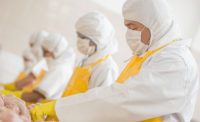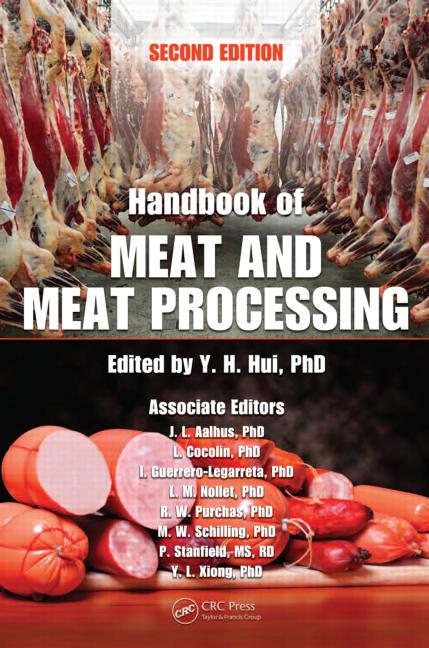Are meat and poultry processing jobs becoming safer? The numbers seem to suggest they are. Injuries are down by almost half from 2004 to 2013, according to last year’s report Workplace Safety and Health: Additional Data Needed to Address Continued Hazards in the Meat and Poultry Industry,” from the Government Accountability Office (GAO).
Certainly, more can always be done to keep meat and poultry workplaces safe. Hazardous conditions such as exposure to chemicals and pathogens, injuries from machines and tools and repetitive injuries remain, reports the Centers for Disease Control and Prevention (CDC).
“The meat industry can be a hazardous workplace,” says Ray Riley, manager of the Rosenthal Center, Texas A&M University, in College Station, Texas. “The good news is the industry is working very hard to make the workplace safer. Today, more safety gear is utilized, equipment manufacturers are designing safer equipment to use, employers are providing safety training to their employees and establishing guidelines to provide worker safeguards.”
Changing corporate cultures
Changes begin at the top with management trying to achieve an injury-free workplace.
But the biggest impact on safety is the culture of the organization and each facility. “Often the corporate message may be to follow safety policies and procedures but they may not be practiced by all individuals or enforced consistently,” says John Johnson, managing director, Epsilon Industries, Sioux City, Iowa.
Hazard recognition — identifying and controlling possible hazards — is another key element in changing the corporate culture regarding workplace injuries. “Identification and control of hazards before an injury occurs is best,” says Hank Bonkers, director of worker safety and human resources at North American Meat Institute, in Washington, D.C. “Investigation of ‘near miss’ incidents identifies a problem before an injury happens.”
Tools such as the National Safety Council’s Journey to Safety Excellence and the Occupational Safety and Health Administration’s (OSHA) Safe and Sound Week participation guide also offer great methods to identify hazards and engage employees, says Bonkers.
Education on worker safety starts at the beginning with orientation and continues with defined safety meeting times, Johnson says.
“New employees are given an orientation training that includes safety topics to prevent and reduce injuries — topics such as knife safety and sharpening improve awareness of the hazards of sharp instruments, as well as the ergonomic benefits of maintaining a sharp blade to reduce gripping force,” Bonkers says. “Understanding other OSHA standards such as Lockout/Tagout, machine guarding, Hazard Communication, emergency action plans, etc., all play a part in initial training.”
Stretching exercises are taught to allow employee muscles to adjust to new demands of the job. Proper posture and lifting techniques are also emphasized, Bonkers says.
“Employees are also given a break-in period during their orientation period to both learn proper techniques and adjust to job demands,” Bonkers says.
Trainers are available to coach new employees as they learn tasks on the production floor.
Ongoing training has been shown to be effective when using interactive tools with visuals, Johnson says.
“The use of computer-based software, video and PowerPoint presentations continue to be the method of choice for delivering safety training,” says Matt Spencer, director of human resources and safety programs at the U.S. Poultry and Egg Association, in Tucker, Ga.
Communicating across barriers
Communication is always a challenge because there are language barriers along with literacy and comprehension levels.
“A number of firms offer specialized training to address such issues and rely on visuals to minimize the language barriers,” Johnson says.
It is not just the language barrier but also cultural issues within work group communities that require understanding of how communication with supervisors is viewed, Bonkers says.
“Management understanding of all of these factors is important in maintaining a strong and safe workplace,” Bonkers says.
Making equipment safer
Equipment manufacturers are improving their manuals and training for safe operation of equipment and safety training for sanitation personnel on how to disassemble, assemble and reassemble equipment.
“It is always a concern for plants that in rushing to get product out the door or trying to get a piece of equipment up and going, not all safety procedures are followed,” Johnson says.
Safety systems are also constantly being upgraded.
“Things such as equipment counterbalances to reduce lifting, scissor lift tables to reduce bending, tilted workstations and adjustable height conveyors are in use to eliminate reaching and bending, electronic guarding to stop band saws when employee fingers get too close,” Bonkers says.
The addition of automation to poultry processing has reduced the risk of injuries.
“New research in wearable technology that captures worker statistical information, including ergonomic-related data, has shown some early promise,” Spencer says. “The development of interactive- and situational-based training has provided workers with the skills to better assess potential risk.”
Remaining challenges
Ergonomics-related injuries are still a challenge as repetitive, manual tasks are still part of many employees’ job descriptions.
“While many repetitive tasks have been successfully automated, efficient and effective technology for deboning chicken and turkey is just entering the market,” notes Spencer.
It can be challenging to show savings on musculoskeletal disorders (MSD) or cumulative trauma disorders (CTD) that haven’t occurred because of preventive programs without a longitudinal study or trend lines, Johnson says.
“The industry, I think, has slipped a bit in regards to MSD and CTD,” Johnson says. There are a number of programs and companies which can provide solutions for facilities with ergonomic issues, but there seems to be a need by companies to show a tangible fiscal benefit.” NP







Report Abusive Comment